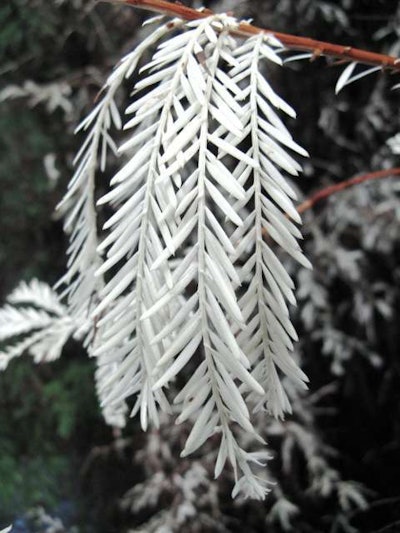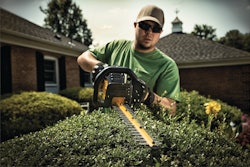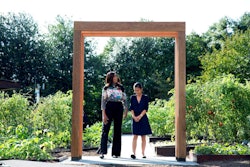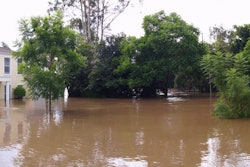 Although albino redwoods look like they’ve been spray painted, they actually lack the green pigment chlorophyll.
Although albino redwoods look like they’ve been spray painted, they actually lack the green pigment chlorophyll.Photo: Mollie C/Flickr
As Halloween creeps closer, some say sightings of ghosts and spirits become more common, but there’s nothing misty about the tree known as the ghost of the California redwoods. In fact, this ghost is about as solid as they come.
An albino variation of the coast redwoods, Sequoia sempervirens, these trees sport white needles instead of green ones. Without the pigment chlorophyll needed to absorb light, the plants are unable to produce their own sugar to survive.
“It shouldn’t be here,” biologist Zane Moore told The Washington Post. “It should be dead, but it’s not. Just like a ghost.”
 Albino redwoods reach a maximum height of about 66 feet.
Albino redwoods reach a maximum height of about 66 feet.Photo: WolfmanSF
Researchers have been baffled by these white iterations of the iconic redwood for more than a century. Since no one has successfully sequenced the 32 billion redwood genomes (humans only have 3.2 billion genomes) scientists have been unable to identify where the mutation actually occurs.
So how do these ghost trees survive? Redwoods can clone themselves, creating vast networks through their root systems, and they make sure nutrients are distributed evenly among themselves during the winter and early spring.
When summer comes, each tree, sprout and branch must photosynthesize enough sugar. Those that fail to do so are cut off from the root system and are shed in the fall. By using this shared root system, the albino redwood is able to survive off the sugar produced by its healthy companions.
For many years, people assumed these trees were merely parasites. According to Moore, people even called them ‘vampire trees.’
However, Moore is challenging that notion, believing there must be a reasonable explanation for why the redwoods let the mutants survive.
“Redwood trees are smarter than that,” said Moore, a doctoral student at the University of California, Davis, and one of the country’s foremost experts on the mysterious ghost trees.
In his search for the answer, Moore and arborist Tom Stapleton set about cataloguing a map of every known albino redwood. By his latest count only 406 exist, but he found that they tended to reside in less favorable growing conditions.
Moore asked fellow redwood fans throughout California to send him clippings from both the albinos and their hosts. He discovered that the white needles were full of the heavy metals cadmium, copper and nickel.
They had nearly twice as many parts per million as their healthy brethren. Some even had enough of the metals to kill them 10 times over. Moore theorizes that the albino plants lose more water than normal due to defective stomata, the pores used for transpiration, causing them to have to take up more water with the heavy metals.
“It seems like the albino trees are just sucking these heavy metals up out of the soil,” Moore told The Washington Post. “They’re basically poisoning themselves.”
 Without their shared root systems these ghost trees would not be able to survive.
Without their shared root systems these ghost trees would not be able to survive.Photo: Cole Shatto
Moore has presented his theory at a redwood conference, noting that the relationship between the white and green redwoods may actually be symbiotic, with the albino trees acting as a reservoir for poison while receiving the energy needed to survive.
To further investigate his theory, Moore plans to test lab-grown redwoods and ghost trees by saturating them with nickel to see if the trees with albinos nearby perform better. He is also curious to see if the heavy metals stay bound up in the white needles or if they eventually leach back into the soil.
If his reasoning proves correct, he hopes the albinos can be used to help make the soil safer for other trees. While this is a nice possible future, Moore knows the threats against the ghost trees are numerous, from profiteers to losing their hosts during the ongoing drought.
“When you’re looking at redwoods, you need to take into account more than just one tree,” he said. “It’s the interactions of the community as a whole that make the forest – that interconnection from root to root to root.”
The ghost trees are found in both Henry Cowell Redwoods State Park and Humboldt Redwoods State Park, but their precise locations are kept secret for their own safety.










